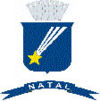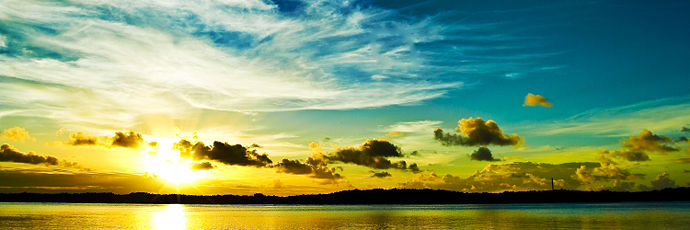Natal, Rio Grande do Norte
| Natal | |||
| — Municipality — | |||
| The Municipality of Natal | |||
|
|
|||
|
|||
| Nickname(s): "Cidade do Sol" ("The City of the Sun") and "Cidade dos Reis" ("City of Kings") | |||
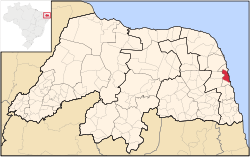 |
|||
| Country | |||
|---|---|---|---|
| Region | Northeast | ||
| State | |||
| Founded | December 25 1599 | ||
| Government | |||
| - Mayor | Carlos Eduardo Alves (PSB) | ||
| Area | |||
| - Municipality | 170.298 km² (65.8 sq mi) | ||
| Elevation | 30 m (98 ft) | ||
| Population (2006) | |||
| - Municipality | 789.896 | ||
| - Density | 4.638.3/km² (12/sq mi) | ||
| - Metro | 1.240.734 | ||
| Time zone | UTC-3 (UTC) | ||
| HDI (2000) | 0.788 – medium | ||
| Website: Natal, Rio Grande do Norte | |||
Natal (Portuguese for "Christmas", pronounced [naˈtaw]) is the capital city of Rio Grande do Norte, a north eastern state in Brazil. As of the IBGE 2006, the city had a total population of 789,896 (1,234,819 in its metropolitan area).
The implementation of the Coastal Highway, a 8 km (4.9 mi) long avenue along the shore, was the true starting point for the beginning of tourist activity in the State in the 1980s. That is where the main hotels and restaurants of the capital city, Natal, are concentrated. Improvements in tourist infrastructure and conservation of the natural heritage, beyond the city's afforestation are some of the actions given priority ever since by the state government. One of the highlights was the creation of the Dune State Park, which aims to preserve the chain of sand dunes that surround the city. And thus, Natal became the entry gate to the beautiful beaches of the State of Rio Grande do Norte. Many of them are still semi-wild, such as Pipa and Pirangi; and others are the liveliest, such as Genipabu and Tibau do Sul.
In accordance with the IPEA (Institute of Applied Economic Research of Brazil), the city is the safest capital of Brazil.
The Augusto Severo International Airport connects Natal with many Brazilian cities and also operates some international flights.
The city is home to the Federal University of Rio Grande do Norte.
Contents |
Geography
| for Natal | |||||||||||||||||||||||||||||||||||||||||||||||
|---|---|---|---|---|---|---|---|---|---|---|---|---|---|---|---|---|---|---|---|---|---|---|---|---|---|---|---|---|---|---|---|---|---|---|---|---|---|---|---|---|---|---|---|---|---|---|---|
| J | F | M | A | M | J | J | A | S | O | N | D | ||||||||||||||||||||||||||||||||||||
|
46
31
24
|
64
31
24
|
111
31
24
|
131
31
24
|
154
30
23
|
180
30
22
|
149
29
21
|
75
28
20
|
30
30
22
|
15
30
23
|
17
31
24
|
29
31
24
|
||||||||||||||||||||||||||||||||||||
| temperatures in °C precipitation totals in mm source: MSN Weather |
|||||||||||||||||||||||||||||||||||||||||||||||
|
Imperial conversion
|
|||||||||||||||||||||||||||||||||||||||||||||||
Natal is located at , in the far east of South America. The city has a total area of 170 km². Natal lies on the Atlantic Ocean, at the mouth of the Potengi river.
Climate and vegetation
Natal has a typical tropical climate, with warm to hot temperatures and high relative humidity all throughout the year. However, these conditions are relieved by a near absence of extreme temperatures and pleasant trade winds blowing from the ocean. January is the warmest month, with mean maxima of 31°C (88°F) and minima of 24°C (75°F), while July is the coolest with mean maxima of 27°C (80.6°F) and minima of 22°C (72°F). Rainfall is heavy at around 1,550 millimetres (61 in) per year, but there is a dry season between about September and January that is more distinct than further south on the Atlantic coast. Nonetheless, the weather is not so dry as to preclude the growth of tropical rainforest and, since colonisation by Portugal, sugar cane.
Known as the "City of Sun" and also as "The City of Dunes" Natal is located in the northeastern tip of Brazil. Lying about 15 degrees south of the equator the sun shines on for more than 3,000 hours every year and the days seem to last forever. The average temperature in Natal is about 27 degrees celsius. During the summer season it normally reaches above 30 degrees celsius with the water at a soothing 26 degrees. The greatest amount of rain falls between March and July.[1]
History



The northeastern tip of South America, Cabo São Roque, 20 miles (32 km) to the north of Natal and the closest point to Europe from Latin America, was first visited by European navigators in 1501, in the 1501-1502 Portuguese expedition led by Amerigo Vespucci, who named the spot after the saint of the day. For decades thereafter, no permanent European settlement was established in the area, inhabited by the Potiguar tribe.
In 1597, after some years during which French pirates, led by Jacques Riffault, established regular commercial activities with the native population, the ninth Portuguese Governor-General of Brazil, Francisco de Sousa, ordered the expulsion of the buccaneers. The successful expedition was led by the Captain-Major of the Captaincy of Pernambuco, Manuel de Mascarenhas Homem, with the assistance of Jerônimo de Albuquerque Maranhão.
Albuquerque Maranhão began on January 6, 1598 the construction of the Fort of the Holy Kings or of the Magi-Kings ("Forte dos Santos Reis" or "Forte dos Reis Magos"), named after the Three Wise Men, honored in the Christian feast of the Epiphany, celebrated on that day.
On December 25, 1599, Natal (whose name means Nativity or Christmas in Portuguese) was established as a village outside the fort. The fort, city, and surrounding areas were occupied by Dutch forces from 1633 to 1654.
The sandy soil of Natal prevented the city from becoming a producer of sugarcane, during the colonial times. For centuries, the economy of the State was based on the raising of cattle in the dry interior lands; the cattle was sent alive to the larger centers, to be used as traction, or was turned into jerked beef, to be used as food; the most typical food of Natal, "carne de sol" (sun meat), has origins in that jerked beef.
Last century, Natal benefited from the growth of the industries of salt (the north of Rio Grande do Norte is the largest producer in Brazil) and petroleum (the largest inland Brazilian reserves are in the State). Natal grew quickly, but in a somewhat planned way (compared to other major Brazilian cities); transit flows smoothly, public services are well distributed, ecologic conscience is visible; violence levels are low. Tourists (first Brazilians, more recently foreigners) discovered the city, which became one of the major tourist destinations in Brazil.
Because of its strategic position (Natal is one of the cities in Brazil nearest to Western Europe and Africa, especially Dakar, Senegal), an American air base was built in a suburb of Natal named Parnamirim during World War II as part of the so-called Operation Rainbow; this base provided support for allied troops combating in the north of Africa. Thousands of American soldiers were sent to Natal, and their presence left traces in the culture of the city.
Economy


With its dozens of sandy, white beaches, such as Ponta Negra and its famous Morro do Careca, Tabatinga - the cliff of dolphins, Pirangi, Redinha, and Jenipabú with its famous fixed sand dunes and imported dromedaries, tourism is the most important industry of Natal, attracting Brazilians, Europeans (many from Spain, England, Scandinavia, Germany, Portugal, Italy and France), and Americans alike.
It is also a relevant administrative center for the oil industry (Rio Grande do Norte being the second largest oil-producing state in Brazil).
The fishing industry is strong (shark cartilage being a major export to Japan) as is the cultivation of tropical fruit, especially mangos, guavas, and cashews (the fruit and the nuts).
In fact, the largest cashew tree in the world is located near the coast in the neighborhood of Pirangi, south of the city center. This tree has a circumference of 500 metres and occupies an area of 7,300 m², making it 70 times the size of average cashew trees.
The GDP for the city was R$ 7,038,816,000 (2005).[2]
The per capita income for the city was R$ 9,047 (2005).[3]
Education

Portuguese is the official national language, and thus the primary language taught in schools, but English and Spanish are part of the official high school curriculum.
The index of basic education in natal is "0,887" which is considered high .
Educational institutions
- Universidade Federal do Rio Grande do Norte (UFRN);
- Universidade Estadual do Rio Grande do Norte (UERN);
- Universidade Potiguar (UnP);
- Federal de Educação Tecnológica do Rio Grande do Norte (Cefet-RN);
- Instituto de Educação Superior Presidente Kennedy (Kennedy);
- Faculdade Natalense para o Desenvolvimento do Rio Grande do Norte (Farn);
- Faculdade de Natal (FAl);
- Faculdade de Excelência Educacional do Rio Grande do Norte (FATERN);
- and many others.
Culture and recreation
Festa Junina (Saint John Festival )



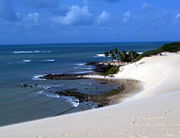
Festa Junina was introduced to Northeastern Brazil by the Portuguese for whom St John's day (also celebrated as Midsummer Day in several European countries), on the 24th of June, is one of the oldest and most popular celebrations of the year. Differently from what happens on the European Midsummer Day, the festivities in Brazil do not take place during the summer solstice but during the tropical winter solstice. The festivities traditionally begin after the 12th of June, on the eve of St Anthony's day, and last until the 29th, which is Saint Peter's day. During these fifteen days, there are bonfires, fireworks, and folk dancing in the streets. Typical foods and beverages are served. It should be noted that, as during Carnival, these festivities involve wearing costumes (in this case, peasant costumes), dancing, heavy drinking, and visual spectacles (fireworks display and folk dancing). Similar to what happens on Midsummer and St John's Day in Europe, bonfires are a central part of these festivities in Brazil.
Carnival
The four-day period before Lent leading up to Ash Wednesday is carnival time in Brazil. Carnival in Natal is not big, but "Carnatal" is a different matter: it's one of the largest off-season carnivals in Brazil.[4] Organizing off-season Carnavais is not a Natal-only habit. Fortaleza has "Fortal", Recife has "Recifolia", Natal has "Carnatal". Carnatal takes place sometime in November or December. It has happened in the streets around Machadão Stadium (traffic around the stadium changes radically during Carnatal days).
The transit department isolates about 3 km (1.8 mi) of streets,[5] creating a ring, along which the party takes place. During the days of party, a huge truck (called "trio elétrico"), with a band on the top and sound boxes all around, drives slowly along the streets. The crowd follows the trio elétrico singing, dancing, jumping to the sound of the music. To be allowed to follow the truck, one must buy admittance to one of the several "blocos" (block). A bloco is an enterprise which obtains permission to participate in Carnatal, hires the band, sells admitance and controls access.
Natal Summer Festival
In January, Rock music and Reggae are performed in the event.
International Fair of Workmanship
In January, workmanships of diverse localities will be in Natal.
Dunas de Genipabu Ecological Park

Considered the second largest urban park in Brazil. It includes 1,172 hectares of land, and allows observation of several vegetable and animal species, which are typical of the Atlantic Forest. The tour is along a trail, accompanied by trained guides. The park also has a jogging track, and stays open for visitors from Tuesday to Sunday.
Museums
Museums in Natal include: Museu de Arte Sacra, Espaço Cultural Palácio Potengi, Instituto Histórico e Geográfico do Rio Grande do Norte, Museu da Cultura Popular, Museum Camara Cascudo, Memorial Camara Cascudo.
Aquarium
The Aquarium was founded and is run by a family of biologists and retired environmentalists. Besides the exhibit, the aquarium also serves as a surgery center for sea animals. The Aquarium is located between the Oceânica Avenue and the beach. The Aquarium exhibits about 60 marine species.[6] There are about 30 small aquariums, where the species are put individually or in small groups of 2 or 3 species. Most species were collected at the Brazilian and Rio Grande do Norte coast. Species include several kinds of fish (including piranhas), sea horses, shrimps, lobsters, stingrays, octopussy, etc. In a refrigerated aquarium, there is a couple of pinguins.
Cashew Tree
The biggest cashew tree in the world. It's registered in the Guiness book as the tree which covers the largest area, 8,400 square meters; that's bigger than a normal football field. Because of a genetic mutation, the branches of this tree grows sideways, instead of upwards; when a branch touches the ground, it doesn't create roots, but a new ramification starts to grow.[7]
Infrastructure
International Airport

Augusto Severo International Airport is the airport serving Natal. It is located in Parnamirim, 18 kilometers (11 mi) from the capital. It lies virtually at sea level (169 ft), with favorable weather and geographic conditions. The airport is the only one in the Northeast Region to receive charter flights from Scandinavia and England.
Highways
Natal is connected to the main cities of Brazil by the BR-101 and BR-304.


Distances
- Recife: 287 km (178 mi);
- São Paulo: 3011 km (1870 mi);
- Rio de Janeiro: 2750 km (1708 mi);
- Belo Horizonte: 2615 km (1624 mi);
- Brasília: 2383 km (1480 mi);
- Salvador: 1100 km (683 mi);
- Porto Alegre: 4320 km (2684 mi).
Port
The Port of Natal is specialized in cold storage cargo such as fruit, fish and shrimp, among others. It has its own customs facilities and is connected to Europe by direct navigation lines, mainly to the ports of Vigo, Rotterdam and Sheerness, which allows great agility and reduced costs for the shipment of your products. Besides having a modern infrastructure, competitive prices and qualified professionals, the access to the management of the Port is easy, meaning less bureaucracy for your transactions.
Neighborhoods




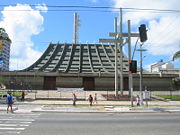
Neighborhoods of Natal:
North Zone
- Potengi
- Redinha
- Pajuçara
- Igapó
- Panatis
- Santa Catarina
- Parque dos Coqueiros
- Alvorada
- Nossa Senhora da Apresentação
- Vale Dourado
- Nova Natal
- Salinas
- Lagoa Azul
East Zone
- Cidade Alta
- Petrópolis
- Tirol
- Alecrim
- Ribeira
- Rocas
- Barro Vermelho
- Santos Reis
- Praia do Meio
- Areia Preta
- Mãe Luíza
West Zone
- Quintas
- Nordeste
- Dix-Sept Rosado
- Bom Pastor
- Nossa Senhora de Nazaré
- Cidade da Esperança
- Cidade Nova
- Planalto
- km 6
- Felipe Camarão
- Guarapes
South Zone
- Ponta Negra
- Lagoa Nova
- Capim Macio
- Candelária
- Neópolis
- Nova Descoberta
- Jiqui
- Pirangi
- Pitimbú
Sports

Stadiums
- João Machado Stadium;
- Maria Lamas Farache Stadium;
- Estrelão dos Reis Magos Stadium (under construction);
- Juvenal Lamartine Stadium;
- and many others.
Natal is one of the 18 remaining candidates to host games of the 2014 FIFA World Cup, which Brazil is scheduled to host.
David Beckham has announced plans for a football academy in Natal, to coincide with the 2014 World Cup.
Notable Natalenses
- Fernanda Tavares, international model
- Clodoaldo Silva, paralympic swimmer
- Oscar Schmidt, basketball player
- Virna Dias, volleyball player
- Marinho Chagas, Football player
- João Café Filho, lawyer and ex-president of Brazil (1954-1955)
- Antônio Filipe Camarão, native american
- Luís da Câmara Cascudo, anthropologist, folklorist, journalist, historian, lawyer, and lexicographer
Sister cities
References
- ↑ Climate of Natal
- ↑ (in Portuguese) (PDF)GDP. Natal, Brazil: IBGE. 2005. ISBN 85-240-3919-1. http://www.ibge.gov.br/home/estatistica/economia/pibmunicipios/2005/tab01.pdf. Retrieved on 2007-07-18.
- ↑ (in Portuguese) (PDF)per capita income. Natal, Brazil: IBGE. 2005. ISBN 85-240-3919-1. http://www.ibge.gov.br/home/estatistica/economia/pibmunicipios/2005/tab01.pdf. Retrieved on 2007-07-18.
- ↑ Carnatal
- ↑ Carnatal Organization
- ↑ Aquarium of Natal
- ↑ The biggest cashew tree of the world
External links
- (Portuguese) Official website
- Rocket launch site Natal
- Natal Travel Guide
- Map of Natal
- Commercial Portal
|
||||||||||||||||||||||||||
|
|||||||||||||||||||||||||||||
|
||||||||||||||||||||
|
|||||

